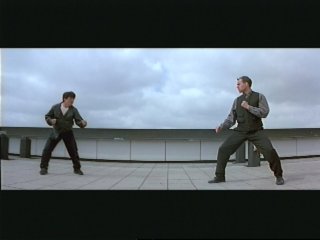|
|
Standard TV's
Standard TV's (4:3 ratio) display widescreen movies in the same width as a movie with the ratio of 1.33. This means that if you are watching a widescreen movie there will be black bars on the top and bottom to convert the 1.33 ratio into the ratio of the movie. If you had a TV that was 52" wide and 39" high, and wanted to watch a movie that has a 2.35:1 ratio. Then your movie would use the entire width of the screen and 22" of the height. The bars that would appear on the top and bottom would be 8.5" high. This can seem like an awful waste of space but see the Pan & Scan section to see what you would miss. The problem is being subdued by Widescreen TV's but it is still a problem to people who are new to Widescreen. "Why are those black bars on the screen" is something I hear all the time.
If I have a movie in both Pan & Scan and Letterbox I will choose the Letterbox all the time. I cannot stand the fact that I'm missing part of the movie. It can be very irritating when you are watching a movie and someone is talking off the screen because the other actor has been cut out in the Pan & Scan process. However if you never knew there was a person there you wouldn't miss them. That is one major problem, education, we have to let people know that there IS something there and they are missing it.
Rather than saying, "Why are these black bars on my screen?" I want people to say "Look at how much more of the movie I can see!"
1.33 Image on Standard Display
This is the actual ratio of a Standard TV. There are no black bars to be seen here. The black bars are to compensate the difference of ratios. Since the ratio of the image and the screen are the same the black bars aren't needed.
|

|
1.66 Image on Standard Display
This image has very small black bars on the top and bottom. This is just to compensate between the ratios since now we are trying to show a 1.66:1 image on a 1.33:1 display.
|

|
1.78 Image on Standard Display
This image has black bars on the top and bottom. This is just to compensate between the ratios since now we are trying to show a 1.78:1 image on a 1.33:1 display. The larger the ratio, the bigger the bars when displayed on a standard display.
|

|
1.85 Image on Standard Display
This image has black bars on the top and bottom. Black bars to compensate between the 1.85 ratio and the 1.33 display device
|

|
2.35 Image on Standard Display
This image has large black bars on the top and bottom. This ratio has the largest black bars but you still are able to see the entire image, rather than cutting off the edges.
|

|
One side note: Some newer TV's support higher resolutions than the signal they are recieving. Some standard TV's can have an anamorphic button, so they can use the higher resolution anamorphic image. The TV would squash the image but still using all the lines of resolution. If you have this button and a DVD player, use it! It should add a bit of resolution to the picture, even though it will be the same size.
|

